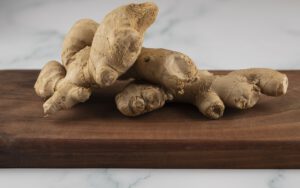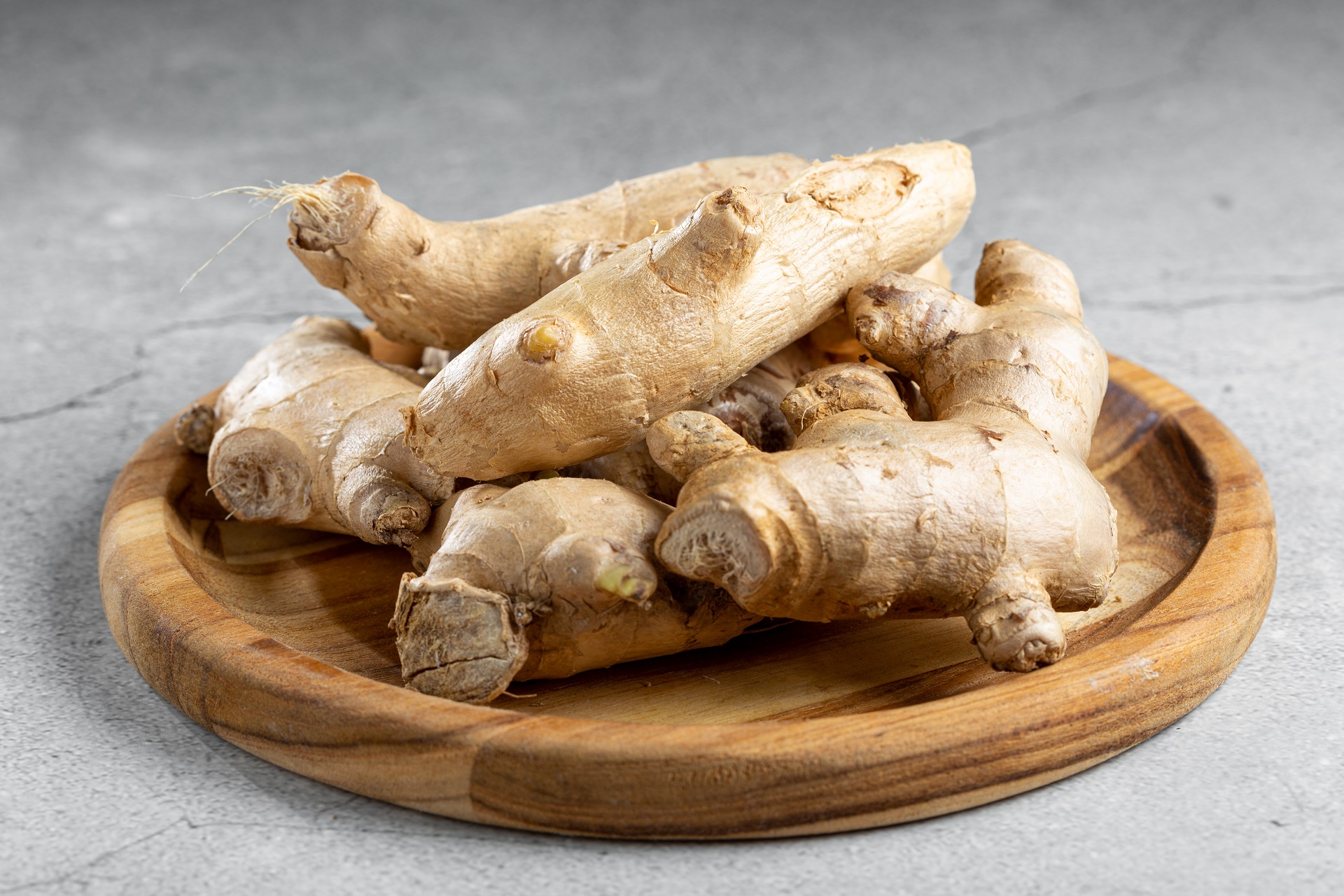Ginseng (Panax ginseng) – definition
Panax ginseng, or proper ginseng or Korean ginseng, has long been used, particularly in Chinese medicine, as an adaptogen to aid in the treatment or prevention of diseases of the human body. The word “pan” means everything and “asos” means medicine, suggesting the medicinal properties of this plant. It is mainly grown in northeastern China, Japan, Korea and eastern Russia. Ginseng has many active constituents, including ginsenosides (R1-R7 or Ra-Rh), carbohydrates (polysaccharides, trisaccharides, disaccharides), phytosterols, polyacetylenes, polyphenols, organic acids, essential oils, amino acids, vitamins and minerals, each of which may contribute to the health properties of this plant. Ginsenosides, or ginseng saponins, are its main active constituents, particularly with regard to anti-inflammatory action. Korean ginseng contains 38 types of ginsenosides in its composition, which is significantly more than in, for example, American ginseng. In addition, it contains more major non-aponin compounds, acidic polysaccharides, phenolic compounds and polyethylene compounds than other ginseng. These compounds are extracted from the roots, stems, leaves, fruits and flowers of ginseng.
Panax ginseng helps to maintain the body’s homeostasis and has been found in studies to have pharmacological efficacy including improved brain function, anti-diabetic properties, blood pressure balancing, enhanced immune system function, analgesic and anti-cancer effects, improved liver function, anti-fatigue and anti-stress properties, reduced severity of menopausal disorders and increased libido, as well as anti-ageing and antioxidant effects.

Ginseng (Panax ginseng) – health properties
Ginsenosides have adaptogenic properties, i.e. support the body’s ability to adapt to changing conditions such as stress, and have a psychostimulant effect, and the effect produced also depends on the type of ginsenoside, one will stimulate and another will have a calming effect. Panax ginseng exerts its anti-inflammatory effects via various mechanisms: activation of the glucocorticoid receptor, antioxidation (inhibition of free radical production and activation of Nrf-2 and HO-1), blocking TLR4 interaction with LPS, activation of anti-inflammatory PPARγ. In addition, several ginsenosides (ginsenoside Rg3, Rb1, Rg1) induce M2 polarisation of macrophages and microglia, which contributes to inhibiting the development of inflammation and promoting its resolution.
In addition, ginseng has immunomodulatory properties, which is realised directly or indirectly by regulating immune cells. Ginseng saponins increase the production of T-lymphocytes, interleukin one and NK cells, which supports the body’s resistance to both viral and bacterial infections. Recent studies report that the plant has anti-inflammatory and immunomodulatory effects on inflammatory bowel disease via regulation of immune cell balance, activation of Toll-like receptor 4, nuclear factor kappa B (NF-κB), mitogen-activated protein kinase signalling, nucleotide-binding oligomerisation domain-like receptor (NLRP) and inhibition of cytokine expression. The results show that long-term administration of ginsenosides has a positive effect on intestinal metabolism and the balance of bacterial flora. In addition, ginsenosides can reduce the severity of chronic dermatitis and psoriasis by regulating IFN-γ, IL1β and TNF-α produced by macrophages and Th cells; besides, these compounds increase mucus secretion, so they have an anti-ulcer effect.
Research data suggest that certain components of ginsenosides protect many organs, tissues and systems. In the cardiovascular system, they protect against myocardial hypertrophy, arrhythmias, cardiomyocyte apoptosis, heart failure and myocardial ischaemia-reperfusion injury. In addition, they support the treatment of neurodegenerative diseases, improving cognitive function and protecting brain tissue. This neuroprotective effect is due, among other things, to the effect on neurotransmitters in Alzheimer’s disease. In addition, in vitro analyses have shown that some ginsenosides are inhibitors of enzymes such as acetylcholinesterase and butyrylcholinesterase, which destroy acetylcholine, the main neurotransmitter involved in this disease.
Ginseng can improve cardiometabolic performance and be helpful in treating diabetes and obesity and regulating insulin levels. This is evidenced by a meta-analysis, which noted that supplementation with this compound significantly reduces fasting blood glucose, the HOMA-IR index, total cholesterol and interleukin-6 levels. However, it increases the level of heart rate and TNF-α. The effects of ginseng on HOMA-IR and HDL-C and LDL-C are dose dependent. In addition, Panax ginseng increases the secretion of nitric oxide, so it has hypotensive properties, but this effect is also dose-dependent and in higher amounts can increase blood pressure.
Panax ginseng may also have a role in the prevention and control of various types of cancer including lung, oesophageal, stomach, liver and breast cancer by inducing apoptosis of cancer cells and inhibiting their proliferation.
Some reports suggest that ginseng may exert antidepressant effects via mechanisms such as modulation of the monoamine neurotransmitter system (increases serotonin in the cortex and increases norepinephrine and dopamine), enhancement of neurotrophic factor expression, anti-inflammatory effects and regulation of hypothalamic-pituitary-adrenal axis function.

Ginseng (Panax ginseng) – use and safety
In general, the effects of ginseng become apparent after using it for several weeks, e.g. 3 months, taking a break of 2-4 weeks. Overuse of this perennial can result in the so-called ginseng syndrome, manifested by diarrhoea, nausea, headaches, hypertension, nervousness. Due to its anticoagulant properties, it is recommended that ginseng be discontinued before surgery or dental appointments.
Bibliography:
Lamer-Zarawska E., Kowal-Gierczak B., Niedworok J.: Fitoterapia i leki roślinne. PZWL, Warszawa, 2007.
Kang Z, Zhonga Y, Wu T, Huang J, Zhao H, Liu D. Ginsenoside from ginseng: a promising treatment for inflammatory bowel disease. Pharmacol Rep. 2021 Jun;73(3):700-711. doi: 10.1007/s43440-020-00213-z. Epub 2021 Jan 19.
Razgonova MP, Veselov VV, Zakharenko AM, Golokhvast KS, Nosyrev AE, Cravotto G, Tsatsakis A, Spandidos DA. Panax ginseng components and the pathogenesis of Alzheimer’s disease (Review). Mol Med Rep. 2019 Apr;19(4):2975-2998.
Im DS. Pro-Resolving Effect of Ginsenosides as an Anti-Inflammatory Mechanism of Panax ginseng. Biomolecules. 2020 Mar 13;10(3):444.
Choi KT. Botanical characteristics, pharmacological effects and medicinal components of Korean Panax ginseng C A Meyer. Acta Pharmacol Sin. 2008 Sep;29(9):1109-18.
Naseri K, Saadati S, Sadeghi A, Asbaghi O, Ghaemi F, Zafarani F, Li HB, Gan RY. The Efficacy of Ginseng (Panax) on Human Prediabetes and Type 2 Diabetes Mellitus: A Systematic Review and Meta-Analysis. Nutrients. 2022 Jun 9;14(12):2401.
Jin Y, Cui R, Zhao L, Fan J, Li B. Mechanisms of Panax ginseng action as an antidepressant. Cell Prolif. 2019 Nov;52(6):e12696.
Ru W, Wang D, Xu Y, He X, Sun YE, Qian L, Zhou X, Qin Y. Chemical constituents and bioactivities of Panax ginseng (C. A. Mey.). Drug Discov Ther. 2015 Feb;9(1):23-32.


